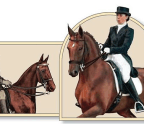Planning Your Horse’s RETIREMENT

Retiring my Thoroughbred gelding, Memphis, from the show ring was an extremely difficult and emotional decision for me. Not only did I feel a sense of grief over losing what had been a big part of my life, but I was also overwhelmed by the question of what was next for our life together.
Memphis, who was 19 years old at the time, had been my faithful partner in hunter/jumper competition for 14 years. Every time we entered the ring, all of life’s stresses melted away, and I was enveloped by a surreal sense of calm. It was just me and my horse, depending on each other.
So when the question of retiring Memphis loomed, it was difficult to contemplate giving all of that up. But in the end, I had no choice. Long before I’d come to own him, Memphis had been involved in an accident that left a baseball-sized chunk of bone missing from his right hip. While he’d been sound throughout his long show career, the unmistakable signs of arthritis set in as he aged. I realized that continuing to ride him in the demanding sport of jumping would hasten the deterioration of his joints, keeping him comfortable would be difficult and worse, his risk of catastrophic injury would grow. I wanted to do right by my friend and repay him for all that he had given me.
It was clear Memphis needed to retire from showing, but what exactly did that mean? For people, retirement used to mean an office party with a sheet cake, followed by a move to warmer climates. But nowadays people take much more varied paths at the end of their working life. The same is true for horses. Equine retirement can mean anything
You’re reading a preview, subscribe to read more.
Start your free 30 days





